
Earlier this month, the Active Transportation Alliance launched a survey that asked a very good question: Where do Chicagoans really want to see new bike lanes? The Chicago Bike Network Vision Survey, available in English and Spanish through June 30, seeks feedback from a wide range of residents on their priorities for new bikeways.
“The city has almost reached Mayor Emanuel’s goal of 100 miles of [buffered and protected bike lanes], and we’re very excited about that,” said Jim Merrell, Active Trans’ director of campaigns. The Chicago Streets for Cycling Plan 2020, developed with input from a series of community meetings, calls for creating a 645-mile bike route network by the end of the decade. “But there’s no longer a sort of organizing goal or clear implementation plan for the next steps,” Merrell said.
With the start of Emanuel’s second term, Active Trans figured it was a good opportunity to reflect on the implementation of the 100-mile goal and determine what types of bikeways, in which locations, should be prioritized in the future. As of mid-May, the city had installed 71.5 miles of buffered bike lanes and 18.5 miles of protected lanes, for a grand total of 90 miles, according to the Chicago Department of Transportation. Not much has been installed yet this spring, but new lanes are slated for Elston, Vincennes, Milwaukee, Lake, Lawrence, and other streets in the near future.
The city originally planned to install 100 miles of protected lanes within Emanuel’s first four years in office, and Merrell said Active Trans would have preferred that a higher percentage included physical separation, rather than simply a painted buffer. “But the mayor’s goal has undeniably been successful in spurring action at a higher rate that we’ve seen before,” he said. “Chicago has done more than just about any other big city, so we should be proud.” However, Active Trans wants to encourage the city to create more robust, low-stress bike routes in the future, Merrell said. The survey is part of that strategy.
In March, the advocacy group met with about two dozen community leaders, including bike advocates and transportation experts, as well as representatives from economic development organizations and grassroots neighborhood groups. “We wanted to determine our shared vision for the future of the bike route network,” Merrell said.
Active Trans also hoped that the community leaders could them help recruit a good cross section of Chicagoans to participate in the survey. “Our big goal is to get new people involved in bike advocacy,” Merrell said. “So the survey is a data collection tool, but it’s also an outreach and organizing tool.”
The questionnaire asks participants to classify themselves in terms of how confident they are biking in the city, and their level of interest, from “Strong and Fearless” to “No Way, No How.” Active Trans wants a maximum number of “Interested but Concerned” cyclists to participate – people who would like to bicycle more but are not fully comfortable riding under current conditions. These are the folks who can best identify the barriers that are keeping more Chicagoans from biking.
Participants are asked which things the city should focus on in order to make cycling safer and more convenient. Do they think it’s most important to improve bike routes that have high crash rates? Should routes around barriers like expressways, railroads, and rivers be prioritized? Is it important that bikeways lead to destinations like ‘L’ stations, schools, parks, libraries, job centers, and retail trips? Are good bike routes especially crucial in “transit deserts”?
Perhaps partly due to the input from community organizations, the survey asks whether areas with health disparities, such as high obesity rates, should be prioritized. High rates of unemployment, crime, and violence are also mentioned as possible reasons to prioritize improving bike access in neighborhoods. At the end of the survey, respondents are asked to identify specific intersections or stretches of road that they find stressful for cycling.
Several hundred people have filled out the questionnaire so far, Merrell said. As an incentive for more people to get involved, Active Trans is raffling off prizes like Divvy tickets, a $50 REI gift certificate, and a Wendella boat tour to those who respond to the survey by the end of the month.
Active Trans will reconvene the community leaders in July to discuss the survey results, and then publish a report by the end of the summer. That document should be useful for letting CDOT know what kind of bike network regular Chicagoans really want. Hopefully, this will help lead to the creation of more bikeways that are safe for everyone from young kids to seniors, and take people where they want to go a convenient and fun way.






